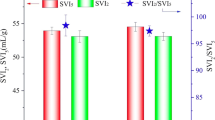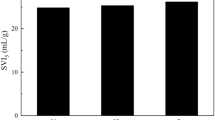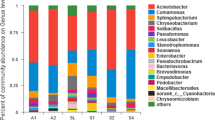Abstract
Microalgal–bacterial granular sludge (MBGS) process has become a focal point in treating municipal wastewater. However, it remains elusive whether the emerging process can be applied for the treatment of aquaculture wastewater, which contains considerable concentrations of nitrate and nitrite. This study evaluated the feasibility of MBGS process for aquaculture wastewater treatment. Result showed that the MBGS process was competent to remove respective 64.8%, 84.9%, 70.8%, 50.0% and 84.2% of chemical oxygen demand, ammonia–nitrogen, nitrate–nitrogen, nitrite–nitrogen and phosphate–phosphorus under non-aerated conditions within 8 h. The dominant microalgae and bacteria were identified to be Coelastrella and Rhodobacteraceae, respectively. Further metagenomics analysis implied that microbial assimilation was the main contributor in organics, nitrogen and phosphorus removal. Specifically, considerable nitrate and nitrite removals were also obtained with the synergy between microalgae and bacteria. Consequently, this work demonstrated that the MBGS process showed a prospect of becoming an environmentally friendly and efficient alternative in aquaculture wastewater treatment.



Similar content being viewed by others
References
Hussein GHG, Chen M, Qi P, Cui Q, Yu Y, Hu W, Tian Y, Fan Q, Gao Z, Feng M, Shen Z (2020) Aquaculture industry development, annual price analysis and out-of-season spawning in largemouth bass Micropterus salmoides. Aquaculture 519:734901
FAO (2020) The State of World Fisheries and Aquaculture 2020. Sustainability in action, Rome
Gao F, Li C, Yang Z, Zeng G, Feng L, Liu J, Liu M, Cai H (2016) Continuous microalgae cultivation in aquaculture wastewater by a membrane photobioreactor for biomass production and nutrients removal. Ecol Eng 92:55–61
Mohd Nizam NU, Mohd Hanafiah M, Mohd Noor I, Abd Karim HI (2020) Efficiency of five selected aquatic plants in phytoremediation of aquaculture wastewater. Appl Sci 10:2712
Leng L, Wei L, Xiong Q, Xu S, Li W, Lv S, Lu Q, Wan L, Wen Z, Zhou W (2020) Use of microalgae based technology for the removal of antibiotics from wastewater: a review. Chemosphere 238:124680
Ramesh M, Thilagavathi T, Rathika R, Poopal RK (2018) Antioxidant status, biochemical and hematological responses in a cultivable fish Cirrhinus mrigala exposed to an aquaculture antibiotic Sulfamethazine. Aquaculture 491:10–19
Khatoon H, Haris H, Rahman NA, Zakaria MN, Begum H, Mian S (2018) Growth proximate composition and pigment production of Tetraselmis chuii cultured with aquaculture wastewater. J Ocean U China 17:641–646
Srimongkol P, Thongchul N, Phunpruch S, Karnchanatat A (2019) Ability of marine cyanobacterium Synechococcus sp. VDW to remove ammonium from brackish aquaculture wastewater. Agr Water Manage 212:155–161
Mook WT, Chakrabarti MH, Aroua MK, Khan GMA, Ali BS, Islam MS, Abu Hassan MA (2012) Removal of total ammonia nitrogen (TAN), nitrate and total organic carbon (TOC) from aquaculture wastewater using electrochemical technology: a review. Desalination 285:1–13
Hai NV (2015) The use of probiotics in aquaculture. J Appl Microbiol 119:917–935
Lukwambe B, Qiuqian L, Wu J, Zhang D, Wang K, Zheng Z (2015) The effects of commercial microbial agents (probiotics) on phytoplankton community structure in intensive white shrimp (Litopenaeus vannamei) aquaculture ponds. Aquacult Int 23:1443–1455
Liu W, Luo G, Tan H, Sun D (2016) Effects of sludge retention time on water quality and bioflocs yield, nutritional composition, apparent digestibility coefficients treating recirculating aquaculture system effluent in sequencing batch reactor. Aquac Eng 72–73:58–64
Shao S, Hu Y, Cheng J, Chen Y (2019) Action of oxytetracycline (OTC) degrading bacterium and its application in Moving Bed Biofilm Reactor (MBBR) for aquaculture wastewater pre-treatment. Ecotox Environ Safe 171:833–842
Barnharst T, Rajendran A, Hu B (2018) Bioremediation of synthetic intensive aquaculture wastewater by a novel feed-grade composite biofilm. Int Biodeter Biodegr 126:131–142
Huang X, Ye G, Yi N, Lu L, Zhang L, Yang L, Xiao L, Liu J (2019) Effect of plant physiological characteristics on the removal of conventional and emerging pollutants from aquaculture wastewater by constructed wetlands. Ecol Eng 135:45–53
Zhimiao Z, Xiao Z, Zhufang W, Xinshan S, Mengqi C, Mengyu C, Yinjiang Z (2019) Enhancing the pollutant removal performance and biological mechanisms by adding ferrous ions into aquaculture wastewater in constructed wetland. Bioresour Technol 293:122003
Liu Y, Lv J, Feng J, Liu Q, Nan F, Xie S (2019) Treatment of real aquaculture wastewater from a fishery utilizing phytoremediation with microalgae. J Chem Technol Biot 94:900–910
Ji B, Zhang M, Gu J, Ma Y, Liu Y (2020) A novel micro-ferrous dosing strategy for enhancing biological phosphorus removal from municipal wastewater. Sci Total Environ 179:115884
Michels MHA, Vaskoska M, Vermuë MH, Wijffels RH (2014) Growth of Tetraselmis suecica in a tubular photobioreactor on wastewater from a fish farm. Water Res 65:290–296
Liu L, Zeng Z, Bee M, Gibson V, Wei L, Huang X, Liu C (2018) Characteristics and performance of aerobic algae-bacteria granular consortia in a photo-sequencing batch reactor. J Hazard Mater 349:135–142
Zhang M, Ji B, Liu Y (2020) Microalgal-bacterial granular sludge process: a game changer of future municipal wastewater treatment? Sci Total Environ 752:141957
Nuramkhaan M, Zhang Y, Dong X, Huang W, Lei Z, Shimizu K, Zhang Z, Utsumi M, Lee D (2019) Isolation of microalgal strain from algal-bacterial aerobic granular sludge and examination on its contribution to granulation process during wastewater treatment in respect of nutrients removal, auto-aggregation capability and EPS excretion. Bioresour Technol Rep 8:100330
Zhang B, Li W, Guo Y, Zhang Z, Shi W, Cui F, Lens PNL, Tay JH (2020) Microalgal-bacterial consortia: From interspecies interactions to biotechnological applications. Renew Sust Energ Rev 118:109563
Lee Y, Sun J (2019) Multifunctional fluorocarbon photobioreactor system: a novel integrated device for CO2 segregation, O2 collection, and enhancement of microalgae growth and bioproductions. Bioproc Biosyst Eng 42:1591–1601
Quijano G, Arcila JS, Buitrón G (2017) Microalgal-bacterial aggregates: applications and perspectives for wastewater treatment. Biotechnol Adv 35:772–781
Meng R, He L, Xi B, Hu X, Li Y (2009) Purifying deteriorated aquacultural water with a bacteria-alga system (in Chinese). Res Environ Sci 22:511–515
Wang S, Ji B, Cui B, Ma Y, Guo D, Liu Y (2021) Cadmium-effect on performance and symbiotic relationship of microalgal-bacterial granules. J Clean Prod 282:125383
APHA (2005) Standard methods for the examination of water and wastewater. American Public Health Association, Washington, DC
Ji B, Wang S, Silva MRU, Zhang M, Liu Y (2021) Microalgal-bacterial granular sludge for municipal wastewater treatment under simulated natural diel cycles: performances-metabolic pathways-microbial community nexus. Algal Res 28:111955
Ji B, Zhu L, Wang S, Liu Y (2021) Temperature-effect on the performance of non-aerated microalgal-bacterial granular sludge process in municipal wastewater treatment. J Environ Manage 28:111955
Ji B, Wang S, Guo D, Pang H (2020) Comparative and comprehensive analysis on bacterial communities of two full-scale wastewater treatment plants by second and third-generation sequencing. Bioresour Technol Rep 11:100450
Ji B, Zhang M, Gu J, Ma Y, Liu Y (2020) A self-sustaining synergetic microalgal-bacterial granular sludge process towards energy-efficient and environmentally sustainable municipal wastewater treatment. Water Res 179:115884
Sutherland DL, Montemezzani V, Howard-Williams C, Turnbull MH, Broady PA, Craggs RJ (2015) Modifying the high rate algal pond light environment and its effects on light absorption and photosynthesis. Water Res 70:86–96
Pujalte MJ, Lucena T, Ruvira MA, Arahal DR, Macián MC (2014) The family rhodobacteraceae. In: Rosenberg E, DeLong EF, Lory S, Stackebrandt E, Thompson F (eds) The prokaryotes. Springer, Berlin
Luo L, Lin X, Zeng F, Wang M, Luo S, Peng L, Tian G (2019) Using co-occurrence network to explore the effects of bio-augmentation on the microalgae-based wastewater treatment process. Biochem Eng J 141:10–18
Courchesne NMD, Parisien A, Wang B, Lan CQ (2009) Enhancement of lipid production using biochemical, genetic and transcription factor engineering approaches. J Biotechnol 141:31–41
Remmas N, Melidis P, Voltsi C, Athanasiou D, Ntougias S (2017) Novel hydrolytic extremely halotolerant alkaliphiles from mature landfill leachate with key involvement in maturation process. J Environ Sci Heal A 52:64–73
Jangir PK, Singh A, Shivaji S, Sharma R (2012) Genome Sequence of the Alkaliphilic Bacterium Nitritalea halalkaliphila Type Strain LW7, Isolated from Lonar Lake, India. J Bacteriol 194:5688–5689
Luo L, He H, Yang C, Wen S, Zeng G, Wu M, Zhou Z, Lou W (2016) Nutrient removal and lipid production by Coelastrella sp. in anaerobically and aerobically treated swine wastewater. Bioresour Technol 216:135–141
Abe K, Hattori H, Hirano M (2007) Accumulation and antioxidant activity of secondary carotenoids in the aerial microalga Coelastrella striolata var. multistriata. Food Chem 100:656–661
Li X, Yang WL, He H, Wu S, Zhou Q, Yang C, Zeng G, Luo L, Lou W (2018) Responses of microalgae Coelastrella sp. to stress of cupric ions in treatment of anaerobically digested swine wastewater. Bioresour Technol 251:274–279
Abinandan S, Shanthakumar S (2015) Challenges and opportunities in application of microalgae (Chlorophyta) for wastewater treatment: a review. Renew Sust Energ Rev 52:123–132
Ji B, Zhang M, Wang L, Wang S, Liu Y (2020) Removal mechanisms of phosphorus in non-aerated microalgal-bacterial granular sludge process. Bioresour Technol 312:123531
He Q, Xie Z, Fu Z, Wang H, Chen L, Gao S, Zhang W, Song J, Xu P, Yu J, Ma J (2021) Effects of phenol on extracellular polymeric substances and microbial communities from aerobic granular sludge treating low strength and salinity wastewater. Sci Total Environ 752:141785
Zhang B, Lens PNL, Shi W, Zhang R, Zhang Z, Guo Y, Bao X, Cui F (2018) Enhancement of aerobic granulation and nutrient removal by an algal-bacterial consortium in a lab-scale photobioreactor. Chem Eng J 334:2373–2382
Mohamed Ramli N, Giatsis C, Md Yusoff F, Verreth J, Verdegem M (2018) Resistance and resilience of small-scale recirculating aquaculture systems (RAS) with or without algae to pH perturbation. PLoS ONE 13:e195862
Risgaard-Petersen N, Nicolaisen MH, Revsbech NP, Lomstein BA (2004) Competition between Ammonia-Oxidizing Bacteria and Benthic Microalgae. Appl Environ Microb 70:5528–5537
Acknowledgements
This research was financially supported by the College Students’ Science and Technology Innovation Fund of WUST (18ZRA023), the Project of Key Laboratory of Healthy and Freshwater Aquaculture, Ministry of Agriculture (ZJK201810) and the National Natural Science Foundation of China (51808416).
Author information
Authors and Affiliations
Corresponding author
Ethics declarations
Conflict of interest
The authors declare that they have no competing interests.
Additional information
Publisher's Note
Springer Nature remains neutral with regard to jurisdictional claims in published maps and institutional affiliations.
Supplementary Information
Below is the link to the electronic supplementary material.
Rights and permissions
About this article
Cite this article
Fan, S., Ji, B., Abu Hasan, H. et al. Microalgal–bacterial granular sludge process for non-aerated aquaculture wastewater treatment. Bioprocess Biosyst Eng 44, 1733–1739 (2021). https://doi.org/10.1007/s00449-021-02556-0
Received:
Accepted:
Published:
Issue Date:
DOI: https://doi.org/10.1007/s00449-021-02556-0




